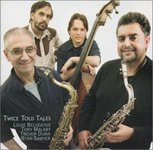|
|
 |
Dusted Reviews
Artist: Louie Belogenis & Tony Malaby Album: Twice Told Tales Label: DIW Review date: Aug. 17, 2003 |

|
|
|
 |
Two Tenor Team-Up
New York City is a big place. When you add in Brooklyn and the other boroughs it can be downright daunting in size. With so much acreage, and so many musicians falling under the seemingly ubiquitous ‘Downtown” designation, any head-scratching on the part of listeners toward tenor saxophonist Louie Belogenis seems at least in part forgivable. Given lengthy tenures in Tucson and his native Minneapolis, Tony Malaby’s horn is even lower profile. In sum, improvising saxophonists can appear a dime a dozen in the Big Apple.
Twice Told Tales serves as a much needed shot in the arm to inoculate against such summary dismissals. Teaming Belogenis and Malaby with a crack rhythm core of Trevor Dunn on upright bass and Ryan Sawyer on traps, this Japanese bankrolled session delivers a baker’s dozen of reasons why obscurity hopefully isn’t a viable outcome for this quartet. On the endearing handwritten note that served as promo preamble for the disc, Belogenis maps out the band’s points of departure from the usual two tenor tandems that have long been a niche custom in jazz. He cites “empathic and poetic interplay” and “alchemical sensibility” among the decisive differentiating factors. Hell, it’s a well-written (if obviously biased) review in and of itself and his assessment seems spot on to my ears. And with the liner notes scribed in a combination kanji and hiragana, it also makes for some convenient context.
But what of the music specifically? Long compositions vie with significantly shorter ones creating appearance of a suite-like structure with tangential interludes. The scripting is so seamless that it’s difficult at times to discern where premeditation ends and extemporization begins. Conversely, Malaby’s silver-lacquered tenor is easily distinguishable from Belogenis’ burnished brass counterpart. The latter’s sound is commonly dry, rasp-inflected and tightly wound, while the former favors a fatter, more girth-guided tone and smoother phrasing style. Though both men often adopt elements of each other’s styles and also turn to other horns including soprano and alto variants. Deferring amiably to the dark forceful drive of Dunn and Sawyer on the opener “Long Ago,” the horns eventually enter with Belogenis testing the terrain on a short melodic reconnaissance and Malaby soon treading the path broken. Near the track’s end, the rhythm section slips unobtrusively into silence leaving the tenors to bob and twine in powerful braiding lines accapella.
Bass and drums achieve an equal footing alongside the frontline pair. Dunn demonstrates stunning facility with sharply bladed bow, scything harmonics from the crisp studio air as cunning counterpoint to the horns on pieces like the somber-patterned “Once.” Sawyer’s succinctly deployed cadences shape the action in staccato fashion on “Calliope,” tugging and pushing in tidal bursts amidst the renal overtone shrieks of the reeds. Captured in the immaculate sonics of Avatar Studios, every nuance, from the tensile twang of tautly snapped strings to the suspirating murmur of brushes on drum skin, is laid bare. The same holds fast for the exquisitely rendered horns, and the minute details of each saxophonist’s individual dialect make for some steadfastly entrancing listening.
Free jazz need not only be about ear-rending howls and instrument-splintering dissonance. Belogenis and Malaby extol the virtues of this truism at length and as such their shared music with Dunn and Sawyer comes across as far more satisfying than the usual horns-bass-drums blowout. It’s this difference that will likely translate into higher visibility for their collective and individual talents on the hardscrabble proving ground that is the New York scene.
By Derek Taylor
|







